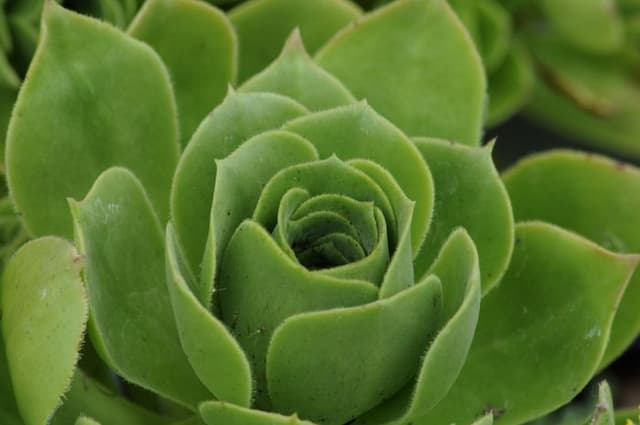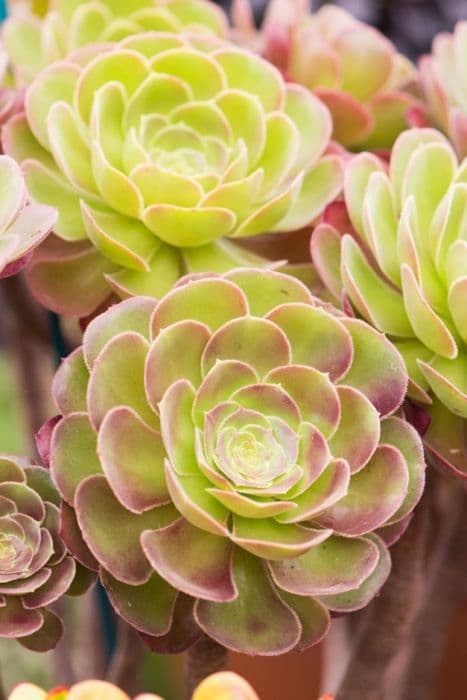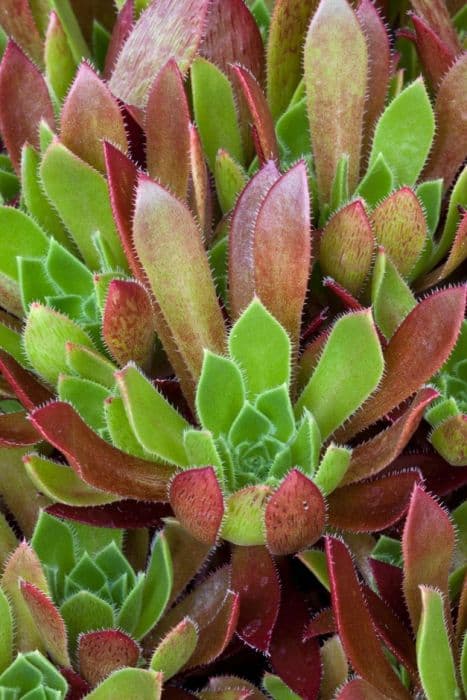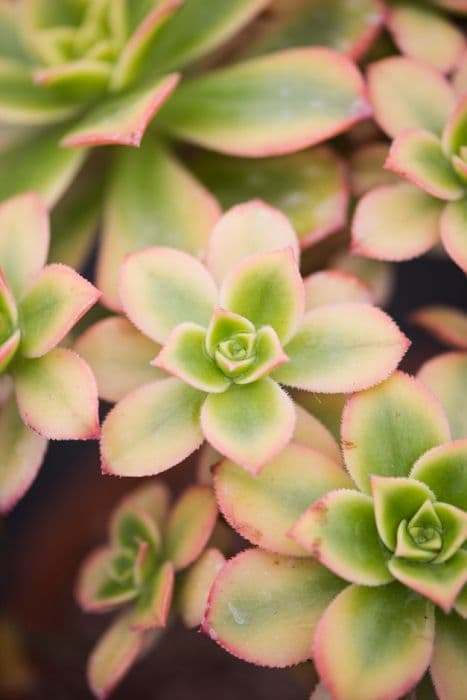Frank Reinelt Echeveria Echeveria 'Frank Reinelt'

ABOUT
Echeveria 'Frank Reinelt' is a succulent plant known for its rosette shape and fleshy leaves. The leaves are thick and spoon-shaped, with a waxy or powdery coating that gives it a pastel appearance. The color of the leaves is a dynamic mix that may include hues of green, blue, or purple, often with a reddish-pink edge that accentuates each leaf’s curved outline. In certain light or during particular seasons, the reddish-pink can become more prominent. The plant has a symmetrical growth pattern with the leaves arranged in a spiraling pattern. This succulent can also produce flower spikes bearing brightly colored bell-shaped flowers which add to its ornamental appeal. The overall look of Echeveria 'Frank Reinelt' is one of compactness and vibrant color, which makes it a favorite among succulent enthusiasts. Its form and coloration can vary depending on growing conditions, such as light exposure and temperature.
About this plant
 Names
NamesSynonyms
Frank Reinelt Velvet Rose, Frank Reinelt Echeveria
Common names
Echeveria 'Frank Reinelt'.
 Toxicity
ToxicityTo humans
Echeveria, the most common common name for Echeveria 'Frank Reinelt', is generally considered non-toxic to humans. There are typically no symptoms of poisoning from ingesting this plant, as it is not known to contain any harmful substances that would cause illness in people.
To pets
Echeveria is also non-toxic to pets, including cats and dogs. There should be no symptoms of poisoning if a pet ingests this plant, and it is unlikely to cause any adverse health consequences.
 Characteristics
CharacteristicsLife cycle
Perennials
Foliage type
Evergreen
Color of leaves
Varies
Flower color
Pink
Height
0.5 feet (15 cm)
Spread
0.5 feet (15 cm)
Plant type
Succulent
Hardiness zones
9
Native area
Mexico
Benefits
 General Benefits
General Benefits- Easy to Care For: Echeveria Frank Reinelt requires minimal maintenance, making it ideal for busy or novice gardeners.
- Drought Tolerant: Once established, it is very drought-resistant, needing water only occasionally, which is a bonus in water-scarce regions.
- Aesthetic Appeal: With its rosette shape and colorful leaves, it adds visual interest to gardens, patios, and indoor spaces.
- Propagation Simplicity: It can be easily propagated from leaf cuttings, enabling gardeners to create more plants without additional costs.
- Year-Round Interest: This succulent maintains its appearance throughout the year, providing enduring beauty irrespective of the season.
- Pest Resistance: Generally, it is resistant to pests, reducing the need for chemical treatments and ensuring a more natural growth environment.
- Non-Toxic: Echeveria Frank Reinelt is safe around pets and humans, as it is not known to be toxic when ingested.
- Compact Growth: Its compact size makes it suitable for growing in small spaces, including small gardens, apartments, or terrariums.
- Versatile: It can be used in various landscape designs, including rock gardens, container arrangements, and as ground cover.
 Medical Properties
Medical PropertiesThis plant is not used for medical purposes.
 Air-purifying Qualities
Air-purifying QualitiesThis plant is not specifically known for air purifying qualities.
 Other Uses
Other Uses- Echeveria 'Frank Reinelt' can be used as a living wreath component, creating a sustainable and attractive decoration that can be refreshed or grown over time.
- This succulent is ideal for use in fairy gardens, providing a low-maintenance, drought-tolerant option that adds a touch of realism to these miniature landscapes.
- The rosettes of Echeveria 'Frank Reinelt' can be used as natural jewelry, such as living brooches or hairpins, by attaching the base to a clip or pin.
- Due to its compact size, this Echeveria species is suitable for use in terrariums, where it can add a sculptural element without overwhelming the space.
- 'Frank Reinelt' can serve as a natural art material, where leaves can be incorporated into mixed media artwork or used as stamps for botanical patterns.
- As a photo prop or backdrop, the striking rosettes of Echeveria 'Frank Reinelt' can add natural beauty and texture to product photography.
- This plant can be used for educational purposes, showcasing the process of propagation and growth in schools or workshops.
- Echeveria 'Frank Reinelt' can be used as a table centerpiece for eco-friendly weddings or events, either on its own or grouped with other succulents.
- Leaves from the Echeveria can be used in creating textured patterns in sand or dirt gardens, showcasing its symmetry and color contrast against a plane surface.
- As a pet-friendly plant, Echeveria 'Frank Reinelt' can be a safe addition to homes with animals, since it's non-toxic and won't harm curious pets.
Interesting Facts
 Feng Shui
Feng ShuiThe Echeveria is not used in Feng Shui practice.
 Zodiac Sign Compitability
Zodiac Sign CompitabilityThe Echeveria is not used in astrology practice.
 Plant Symbolism
Plant Symbolism- Perseverance: Echeverias, including the 'Frank Reinelt', are succulents known for their ability to thrive in harsh, arid conditions, symbolizing the ability to persevere and endure through tough times.
- Timelessness: With their rosette form that remains visually consistent as they grow, Echeveria 'Frank Reinelt' is often associated with timelessness and enduring beauty.
- Self-Reliance: Succulents like the Echeveria 'Frank Reinelt' store water in their leaves, stems, or roots, representing self-sufficiency and the capacity for self-care.
- Adaptability: This plant can adapt to various lighting conditions, symbolizing flexibility and the ability to thrive in diverse environments.
- Protection: The thick, fleshy leaves of the Echeveria 'Frank Reinelt' can be seen as a symbol of protection and defense, as they store water to protect the plant from drought.
 Water
WaterSucculents like the Echeveria 'Frank Reinelt' require minimal watering, following the 'soak and dry' method—fully saturate the soil then let it dry out completely before watering again. Typically, watering once every two weeks should be sufficient, but this can vary depending on the humidity and temperature conditions. During the growing season in spring and summer, you may need to water more frequently but cut back in the fall and winter when the plant goes dormant. When you water, you should use about 5-6 ounces for a small pot around 4 inches in size—larger pots will require more relative to their size. Always avoid water on the leaves to prevent rot.
 Light
LightEcheveria 'Frank Reinelt' thrives in bright, indirect sunlight but can tolerate direct sunlight for part of the day, especially in the morning. The best spot for this succulent would be near a south-facing or east-facing window where it would get ample light without the harsh afternoon sun. If natural sunlight is limited, grow lights can be used as a supplement to ensure the plant gets the light it needs to maintain color and form.
 Temperature
TemperatureThe Echeveria 'Frank Reinelt' prefers a warm climate and does well in temperatures between 65 and 80 degrees Fahrenheit. It is not frost-hardy and needs protection from temperatures below 30 degrees Fahrenheit. Ideally, keep this succulent in an environment that doesn't drop below 50 degrees Fahrenheit at night to prevent stress and potential damage.
 Pruning
PruningPruning an Echeveria 'Frank Reinelt' is typically done to remove dead or dying leaves and to maintain its rosette shape. Gently pluck away any dead leaves at the base of the plant as needed. Additionally, after the plant flowers, you can cut back the flower stalks to direct energy back to the rosette. Pruning is best done in the spring or early summer, which is usually after the plant has finished flowering.
 Cleaning
CleaningAs needed
 Soil
SoilThe ideal soil mix for Echeveria 'Frank Reinelt' includes a well-draining potting mix with perlite, pumice or coarse sand to aid drainage. This succulent prefers a soil pH between 5.5 and 6.5.
 Repotting
RepottingEcheveria 'Frank Reinelt' should be repotted every two to three years or when it outgrows its current pot to refresh the soil and promote healthy growth.
 Humidity & Misting
Humidity & MistingEcheveria 'Frank Reinelt' prefers dry air with low humidity levels, typical of arid conditions found in its native habitat.
 Suitable locations
Suitable locationsIndoor
Place in bright light, avoid overwatering, ensure good airflow.
Outdoor
Full to partial sun, protect from heavy rain, well-draining soil.
Hardiness zone
9-11 USDA
 Life cycle
Life cycleEcheveria 'Frank Reinelt', commonly known as Mexican Hen and Chicks, begins its life as a seed that germinates in well-draining soil with adequate warmth and light. After germination, it grows into a rosette of thick, fleshy leaves, a phase which can last for several years as the plant slowly increases in size. As it matures, the rosette may produce offsets or "chicks," which can be separated and planted to propagate new plants. Periodically, usually during the warmer months, it sends up a tall flowering stalk from the center of the rosette, which bears brightly colored, bell-shaped flowers. After flowering, the main rosette may eventually die back, with the "chicks" growing to take its place, thus continuing the life cycle. Throughout its life, the Echeveria 'Frank Reinelt' requires minimal water and enjoys bright light, embodying the typical growth habits of succulents.
 Propogation
PropogationPropogation time
Spring-Summer
The Echeveria 'Frank Reinelt', commonly known as a variety of succulent, can be propagated primarily by leaf cuttings, a highly popular method due to its simplicity and effectiveness. To propagate by leaves, a healthy, plump leaf is gently twisted off the stem, ensuring that it is a clean pull without leaving any part of the leaf on the stem. This leaf is then left to dry for a few days until the cut end callouses over, which helps prevent rot. Next, the leaf is placed on top of a well-draining soil mix and given minimal water until roots begin to develop—a light misting every few days should suffice. With proper care, a new rosette will eventually form at the base of the cutting, and once this new plant has established a sufficient root system, typically within a few weeks to months, it can be transplanted into its own pot.









